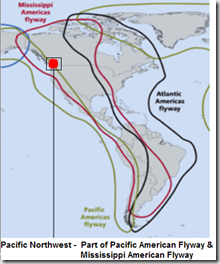# 9602
Over the past month we’ve been following reports of HPAI H5 viruses being spread by migratory birds in the Pacific Northwest, California, and Utah (see here, here & here). While a few backyard flocks have been affected, thus far we’ve seen no evidence of commercial poultry farms being affected.
All of this came to light after British Columbia detected HPAI H5N2 in commercial farms in the Fraser Valley last month, which led to extensive testing of wild and migratory birds both in Canada and the Pacific Northwest (see Fraser Valley B.C. Culling Poultry After Detecting H5 Avian Flu).
Today APHIS, the USDA’s Animal Plant Health Inspection Service, has released an update on the detection of the highly pathogenic avian viruses that appear to be spreading via the Pacific Migratory Flyway, which runs north to south from Siberia to Patagonia.
It should be noted that while related to the H5N1 virus – which has killed several hundred people around the globe – these particular H5 viruses (H5N2 & H5N8) have not demonstrated a similar ability to infect and sicken humans.
Update on Avian Influenza Findings in the Pacific Flyway
Last Modified: Jan 20, 2015
The United States Department of Agriculture has confirmed several findings of highly pathogenic avian influenza (HPAI) in the Pacific flyway since mid-December. These findings are limited to wild birds and backyard poultry flocks that have access to the outdoors. These viruses have NOT been found in any commercial poultry in the United States. Commercial poultry producers follow strict biosecurity practices and raise their birds in very controlled environments.
No human cases with these viruses have been detected in the United States, Canada or internationally. There is no immediate public health concern as a result of these detections.
Backyard poultry findings confirmed by USDA’s National Veterinary Services Laboratories include:
- HPAI H5N8 in a backyard poultry flock in Winston, Oregon (December 19)
- HPAI H5N2 in a backyard poultry flock in Benton County, Washington (January 3)
- HPAI H5N2 in a backyard poultry flock in Benton County, Washington (January 9)
Captive wild bird findings confirmed by USDA’s National Veterinary Services Laboratories:
- HPAI H5N8 in captive gyrfalcons in Whatcom County, Washington (December 16)
Wild bird findings confirmed by USDA’s National Veterinary Services Laboratories are available here.
The findings are part of our increased AI surveillance in the Pacific flyway and increased outreach to backyard poultry enthusiasts. USDA is coordinating closely with its partners, including Washington, Oregon and California State officials, the U.S. Department of the Interior and the U.S. Department of Health and Human Services, on avian influenza surveillance, reporting, and control efforts. The United States has the strongest AI surveillance program in the world, where we actively look for the disease and provide 100% compensation to affected producers to encourage reporting.
Because the H5N2 and H5N8 avian influenza strains are currently circulating in migratory birds in the Pacific flyway, we anticipate our active surveillance will result in additional findings in both wild birds and in backyard flocks with access to the outdoors. However, because of our commercial producers’ continuing vigilance, U.S. poultry is safe.
USDA continues to report these findings to the World Animal Health Organization (OIE) as part of the ongoing Pacific flyway avian influenza incident. USDA is working with trading partners to minimize trade impacts on poultry and poultry products as much as possible.
While neither virus has been found in commercial poultry, USDA emphasizes that poultry, poultry products and wild birds are safe to eat if they are properly handled and cooked to a temperature of 165 degrees Fahrenheit.
All bird owners, whether commercial producers or backyard enthusiasts, need to continue practicing good biosecurity, preventing contact between their birds and wild birds, and reporting sick birds or unusual bird deaths to State/Federal officials, either through your state veterinarian or through USDA’s toll-free number at 1-866-536-7593. Additional information on biosecurity for backyard flocks can be found at healthybirds.aphis.usda.gov
While good biosecurity can protect commercial poultry flocks - as we’ve seen in recently in Canada, Taiwan, Japan, South Korea, and even in Europe – breaches are not unheard of. For more on how avian flu viruses can (and have) spread via migratory birds, you may wish to revisit.
FAO On The Potential Threat Of HPAI Spread Via Migratory Birds
Bird Flu Spread: The Flyway Or The Highway?
